Home | About |
News |
Calendar |
Documents |
Links |
Info | Contact
This is not the official document, you should not rely on this hypertext
version for legal purposes. This hypertext version is intended to help you
find references to various topics. Send comments or corrections to
webmaster@chestnuttrails.org
Arborist's
Report
Chestnut Trails Homeowners Association
Bothell, Washington
3 / 20 / 06
Contents
The
process of evaluating tree health and condition involves gathering
information in the field, determining the significance of that information
and producing a report of the findings. In producing and explaining the
findings each report is designed to be readily understood and able to stand
alone, with no further reference being required by the reader. To that end,
each report contains the following sections; Overview. Describes the events
that precipitated the evaluation and identifies the subject, owner and
location. Tree Inspection, containing an explanation of the field work
techniques and methods and instruments used in analysis. Observations, With
site and tree specific information and commentary. Conclusions, An
interpretation of the field work observations, testing and analysis, with
recommendations for treatment.
The
community of Chestnut Trails was developed on an old woodland site. Areas of
the pre-existing woodland were set aside as Native Growth Protection
Easements (NGPE’s). These NGPE’s are effectively areas of remnant forest,
stands of trees that were formally part of a larger group of trees that were
cleared during the development of the site and the associated
infrastructure. Following the failure of several trees concerns were raised
by the community about the health and stability of the remaining trees. In
1997 a Tree Inspection was requested to evaluate the trees and to advise on
methods and procedures to minimize the hazard posed by the trees to the
community. As part of the recommendations repeated Inspections were advised.
This is the report of the Inspection which was carried out in March of 2006.
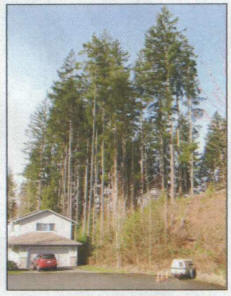 To develop an accurate picture of tree health and condition, information
must be gathered about the multiple, changeable, factors which influence
tree vitality and stability. Vital, healthy tree growth is the result of a
complex association of internal and external influences and to consider each
tree as an isolated entity is to fall short in understanding the whole
picture. As a practical matter, this information must be gathered and
structured in the best way to communicate the results of the observations
and to impart any recommendations for treatment.
To develop an accurate picture of tree health and condition, information
must be gathered about the multiple, changeable, factors which influence
tree vitality and stability. Vital, healthy tree growth is the result of a
complex association of internal and external influences and to consider each
tree as an isolated entity is to fall short in understanding the whole
picture. As a practical matter, this information must be gathered and
structured in the best way to communicate the results of the observations
and to impart any recommendations for treatment.
Individual tree inspection begins at
ground level; tree genus and species is determined and soil quality, rooting
conditions, soil level, irrigation and drainage characteristics are
observed. Soil is a living micro-system that relies on an active working
relationship between structural and living organic components. The
structural condition of the soil is most commonly adversely affected.
The quality of the soil may be
assessed in its ability to contain and disperse available moisture and the
level of soil compaction may be tested to evaluate the aeration capacity of
the soil. Some soil types are easily compacted and although they are high in
nutrient quantity, little of that nutrient quality is available to the
growing tree. Compact soils also cause problems by restricting the trees
ability to discharge the gasses produced as part of the growth cycle.
The visible parts of the tree, the trunk, branches and leaves live in
balance with the unseen roots. Damage to the soil leads to inhibited root
growth and causes a lack of vitality and decline within the tree as a whole.
Soil compaction is commonly the result of heavy traffic in the root zone.
The effects of soil compaction may not become apparent in the tree for
decades following the initial compaction event.
If signs of stress are present, a soil
test may be made to assess the fertility of the soil. Testing establishes
the presence and degree of vital nutrients and micro-flora. Vital soil is
essential to vital tree growth, the presence of nutrients and organisms
within the soil mean that growth can continue. An imbalance of nutrients can
cause poor vitality; often exhibited by leaf discoloration or lack of annual
growth. Poor nutrition will slow growth and can diminish the trees natural
defense mechanisms and expose the tree to disease.
In nature, few tree species grow
alone; the forest is their natural and protected setting. Whether native or
introduced, irregardless of a trees origin, trees in a landscape setting
demand special attention. Although bound by the genetic code of its
predecessors each tree is also the product of its local environment in terms
of health and stability.
Looking at the overall picture, the
health of the soil, turf and other plants and trees can reveal the cause of
disease, or indicate potential problems. The presence of certain species of
fungus can indicate decay. Certain decay fungi may destroy support tissues
and leave conductive tissues unharmed. The tree may appear healthy and
continue to grow until the internal decay outpaces the new outer growth.
A root crown examination may be
necessary if root decay is suspected. By removing the soil at the base of
the tree the location, health and condition of the absorbing and support
roots can be determined.
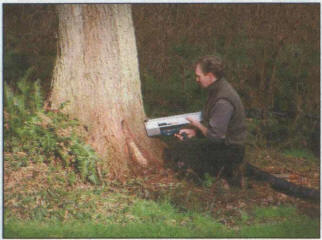 In the primary examination of the root crown and trunk a mallet is used to
test for loose bark. Bark lifting can indicate dead or hollow areas and give
signs of the presence of decay in the root crown zone and at the base of the
trunk. The mallet may be used to "sound" for decay but has limited
reliability. If decay is suspected the tree will be tested using the
Resistograph. The Resistograph is an instrument that inserts a constant
velocity probe into the suspect area of the tree. The resistance to the
probe is graphed by the machine.
In the primary examination of the root crown and trunk a mallet is used to
test for loose bark. Bark lifting can indicate dead or hollow areas and give
signs of the presence of decay in the root crown zone and at the base of the
trunk. The mallet may be used to "sound" for decay but has limited
reliability. If decay is suspected the tree will be tested using the
Resistograph. The Resistograph is an instrument that inserts a constant
velocity probe into the suspect area of the tree. The resistance to the
probe is graphed by the machine.
 The
graph profile can tell a great deal about the internal character of the
wood. Internal defects can be detected, cracks, hollows and early stage
decay. The type of decay and its effect on the stability of the wood depends
on the species of fungus involved. Soil and root tissue samples may be taken
to determine the cause of disease by laboratory testing.
The
graph profile can tell a great deal about the internal character of the
wood. Internal defects can be detected, cracks, hollows and early stage
decay. The type of decay and its effect on the stability of the wood depends
on the species of fungus involved. Soil and root tissue samples may be taken
to determine the cause of disease by laboratory testing.
The inspection continues with an
evaluation of the tree crown, first by eye or with the use of binoculars
then, if necessary, by climbing into the canopy of the tree. The color, size
and condition of the leaves, trunk, branches and twigs is assessed. The form
and formation of all the trees components give information about health,
vitality and structural strength. The crown density, the number of leaves on
each stem, and past and current growth extension, indicate current health
and reveal previous problems. Changes in growth rate in older growth may
indicate prior disease or injury.
An evaluation of the general growth
habit will reveal any problems related to vigor, or the genetic component of
tree growth. Previous treatments such as pruning or cabling are observed,
the quality of the work, and its effect on the tree. Any growth
abnormalities are noted: weak limbs, discolored or missing bark, cracks or
cavities in branches or trunks. Indications of disease are observed within
the canopy of the tree, disease may be indicated by leaf blight, stem
canker, fungal growth or insect and bird activity.
Trees produce adaptive growth to
compensate for the stress related to growth and injury .The shape and
formation of limbs and trunks can show the ability of the tree to compensate
for weakness or indicate internal problems that may lead to limb or trunk
breakage. The interpretation of these changes in form is part of a growing
body of knowledge pioneered in Europe. The knowledge is not new but the
application is: Dr. Claus Mattheck of the Karlsruhe Institute and
colleagues, have developed a system of structural evaluation based on the
principals of bio-engineering. I have chosen to use this approach to augment
my own knowledge and experience.
In previous reports the Native Growth
Protection Easements were delineated and placed on a sketch plan. The sites
of previous failures were mapped along with sites within the NGPE’s that
were known (diagnosed) disease sites. The areas within the NGPE’s that were
areas of high failure potential were mapped as were the high target zones.
The tree failures within the NPGE’s
are ongoing: the revised
sketch map shows the recent failure sites. Examination of the failure
sites reveals that failure is due to a combination of high exposure and root
disease. Inspection of the root crown areas of the trees shows that the
disease that produced the root decay and lead to the failure is Laminated
Root Rot.
Laminated Root Rot also known as
yellow ring rot affects conifers in Japan, Manchuria and western North
America from southern Oregon to British Columbia. In North America two
distinct forms exist. In Washington state one form occurs through the
eastern Cascades and eastern Washington. The second form is found here in
western Washington. Different species are affected by the different strains.
The eastern form primarily affects Western Redcedar (Thuja plicata)
and the western form affects the Douglas fir (Pseudotsuga menziesii)
The disease occurs mainly in forests
that are managed for timber production but is often found in landscaped
settings where stands of trees remain following the clearing of a wooded
area. Trees susceptible to the disease in Western Washington include;
Mountain Hemlock (Tsuga mertensiana) Douglas Fir (Pseudotsuga
menziesii) Grand Fir (Abies grandis) Pacific Silver Fir (Abies
amabilis) and White Fir (Abies concolor).
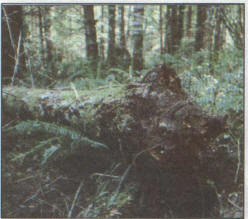 Trees may be infected at a young age but the disease is seldom noticed until
the trees are at least ten years old. Most destruction occurs in trees
between 25 and 125 years old. The majority of the trees are blown down while
still alive. Failure is due to root decay caused by the fungus, Phellinus
weiril, which digests the woody support roots while absorbing root
activity continues. New growth continues while older root and trunk tissues
are decayed. The typical pattern of decay shown in the photograph above
leaves only stubs of support roots showing following failure.
Trees may be infected at a young age but the disease is seldom noticed until
the trees are at least ten years old. Most destruction occurs in trees
between 25 and 125 years old. The majority of the trees are blown down while
still alive. Failure is due to root decay caused by the fungus, Phellinus
weiril, which digests the woody support roots while absorbing root
activity continues. New growth continues while older root and trunk tissues
are decayed. The typical pattern of decay shown in the photograph above
leaves only stubs of support roots showing following failure.
Laminated root rot spreads on site by
growing through the soil via root contacts. Diseased trees and the stumps of
fallen trees should be considered infection sites and the fungus is capable
of surviving on decaying stumps for over 50 years. An area of fifty feet
around a diseased stump is a potential infection zone all susceptible trees
that fall within this area may be infected.
 The above ground symptoms of the disease are often subtle. The growth within
the upper canopy of some trees is reduced; this can cause a “rounding of the
crown” shown as D in the photograph at left. Conifers typically have
a dominant central leader shown as H. When the disease slows growth
the leader is first affected, the surrounding limbs continue to grow forming
the rounded crowns shown above.
The above ground symptoms of the disease are often subtle. The growth within
the upper canopy of some trees is reduced; this can cause a “rounding of the
crown” shown as D in the photograph at left. Conifers typically have
a dominant central leader shown as H. When the disease slows growth
the leader is first affected, the surrounding limbs continue to grow forming
the rounded crowns shown above.
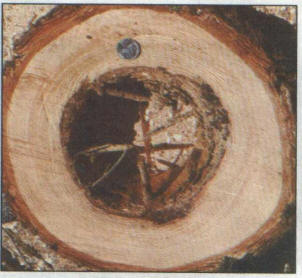 A
disease center may be indicated by a group of trees with rounded crowns
surrounded by trees with strong central leaders.
A
disease center may be indicated by a group of trees with rounded crowns
surrounded by trees with strong central leaders.
The base of some trunks may be decayed
at the root crown level close to the ground. This decay can be detected in
standing trees with the use of the Resistograph.
The symptoms described above may also
be attributed to a number of other forms of disease and further examination
is necessary to determine that Phellinus weirii is at work.
 Positive diagnosis of Laminated Root Rot is made through the microscopic
examination of root tissues. Shown at left the hair like growth is known as
setal hyphae and is a fungal structure which shows that Phellinus weirii
is present.
Positive diagnosis of Laminated Root Rot is made through the microscopic
examination of root tissues. Shown at left the hair like growth is known as
setal hyphae and is a fungal structure which shows that Phellinus weirii
is present.
Extensive de-lamination of wood
tissues and decay are to be expected where setae are present.
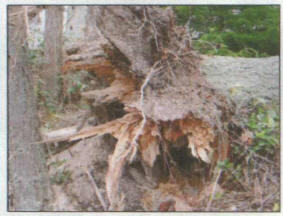 Examination of recent failures shows that Laminated Root Rot is the primary
cause of decay and a major factor in the failure of the trees. New disease
sites have been discovered and the disease sites that were located in
previous inspections appear to be expanding.
Examination of recent failures shows that Laminated Root Rot is the primary
cause of decay and a major factor in the failure of the trees. New disease
sites have been discovered and the disease sites that were located in
previous inspections appear to be expanding.
The above ground symptoms of the
disease are described above and include a loss of central dominance in the
crown of the tree. Examination of the disease sites at Chestnut Trails also
shows that the trees adjacent to disease sites are exhibiting a loss of
vitality. The reduction in vitality is indicated by general thinning of the
leaf area of the tree. Fewer and smaller needles are present and leaf color
is lighter. Where these indicators are present in trees adjacent to know
infection sites Laminated Root Rot is assumed to be present in the roots of
those trees.

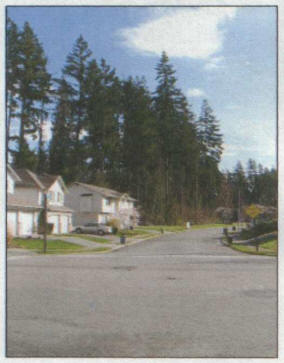
The two photographs above are provided to illustrate the difference in
canopy density and leaf color. Shown at left are trees adjacent to a known
disease site; and at right where no disease site has been discovered.
 Tree
failure at Chestnut Trails is ongoing. The trees blow over in high wind
conditions. The failure of the trees is the product of the alteration in
exposure produced by the clearing necessary to develop the site in
combination with the presence of root disease.
Tree
failure at Chestnut Trails is ongoing. The trees blow over in high wind
conditions. The failure of the trees is the product of the alteration in
exposure produced by the clearing necessary to develop the site in
combination with the presence of root disease.
Clearly the current level of risk posed in retaining
diseased trees in an exposed position is untenable. The likelihood of
additional property damage and the potential for injury increase with time.
Measures must be taken to minimize the risk associated with the trees.
Clearly a decayed tree has an increased likelihood of
failure. Where there is a likelihood of failure there is the possibility of
injury and damage. Trees, although generally long lived, are organic
structures with a finite life cycle, which includes senescence and decline.
They are also shedding organisms that periodically cast off parts to manage
disease and to provide for growth. Each of these elements involves a degree
of risk. Much of the risk can be managed by cultural techniques such as
pruning or additional structural support. To remove all risk associated with
trees would call for the removal of all trees. As a solution, wholesale tree
removal is neither prudent nor practical. To live with trees is to assume
some level of risk. The degree of risk that is acceptable must be determined
by the owner or manager of the property on which the tree resides. The goal
here is to provide a conservative assessment of the current condition of
trees with an assessment of the associated risk and recommendations for
action where appropriate.
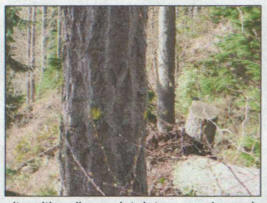 Given
the frequency of tree failure at Chestnut Trails immediate steps should be
taken to reduce hazard. Having located disease sites and pinpointed the
areas of high exposure the trees that show an elevated risk of failure have
been identified. The trees are marked on site with yellow paint dots on each
quadrant of the trunk. The marked trees are also located on the sketch plan.
These trees should be removed. The sketch plan has also been revised to show
expanded disease sites and suspected disease sites.
Given
the frequency of tree failure at Chestnut Trails immediate steps should be
taken to reduce hazard. Having located disease sites and pinpointed the
areas of high exposure the trees that show an elevated risk of failure have
been identified. The trees are marked on site with yellow paint dots on each
quadrant of the trunk. The marked trees are also located on the sketch plan.
These trees should be removed. The sketch plan has also been revised to show
expanded disease sites and suspected disease sites.
Given the extent of the ongoing attrition of the NGPE’s
due to tree failure and the necessary removal of trees, re-planting is more
important than ever if the value of the woodland areas is to be retained.
Past reports have included planting recommendations and a species list.
Because of the nature of the site and the endemic disease problems, species
choice is limited.
The following is a list of trees that are Resistant and
Immune to this variety of Laminated Root Rot. The native species are shown
in green:
Resistant
- Alaska-cedar Cupressus nootkatensis
- Incense-cedar Libocedrus decurrens
- Ponderosa pine Pinus ponderosa
- Port-Orford-cedar Chamaecyparis lawsoniana
- Redwood Sequoia sempervirens
- Western Redcedar Thuja plicata
Immune
- All broadleaf trees (deciduous)
- Bigleaf Maple Acer macrophyflum
- Red Alder Alnus rubra
- Vine Maple Acer circinatum
I hope this information proves useful please let me know
if you have any further questions.
Yours sincerely
Robert W. Williams
Consulting Arborist PN 0176A
Copyright © 2008 Chestnut Trails. All rights reserved.
Home | About |
News |
Calendar
| Documents |
Links |
Info | Contact
 To develop an accurate picture of tree health and condition, information
must be gathered about the multiple, changeable, factors which influence
tree vitality and stability. Vital, healthy tree growth is the result of a
complex association of internal and external influences and to consider each
tree as an isolated entity is to fall short in understanding the whole
picture. As a practical matter, this information must be gathered and
structured in the best way to communicate the results of the observations
and to impart any recommendations for treatment.
To develop an accurate picture of tree health and condition, information
must be gathered about the multiple, changeable, factors which influence
tree vitality and stability. Vital, healthy tree growth is the result of a
complex association of internal and external influences and to consider each
tree as an isolated entity is to fall short in understanding the whole
picture. As a practical matter, this information must be gathered and
structured in the best way to communicate the results of the observations
and to impart any recommendations for treatment. In the primary examination of the root crown and trunk a mallet is used to
test for loose bark. Bark lifting can indicate dead or hollow areas and give
signs of the presence of decay in the root crown zone and at the base of the
trunk. The mallet may be used to "sound" for decay but has limited
reliability. If decay is suspected the tree will be tested using the
Resistograph. The Resistograph is an instrument that inserts a constant
velocity probe into the suspect area of the tree. The resistance to the
probe is graphed by the machine.
In the primary examination of the root crown and trunk a mallet is used to
test for loose bark. Bark lifting can indicate dead or hollow areas and give
signs of the presence of decay in the root crown zone and at the base of the
trunk. The mallet may be used to "sound" for decay but has limited
reliability. If decay is suspected the tree will be tested using the
Resistograph. The Resistograph is an instrument that inserts a constant
velocity probe into the suspect area of the tree. The resistance to the
probe is graphed by the machine.
 The
graph profile can tell a great deal about the internal character of the
wood. Internal defects can be detected, cracks, hollows and early stage
decay. The type of decay and its effect on the stability of the wood depends
on the species of fungus involved. Soil and root tissue samples may be taken
to determine the cause of disease by laboratory testing.
The
graph profile can tell a great deal about the internal character of the
wood. Internal defects can be detected, cracks, hollows and early stage
decay. The type of decay and its effect on the stability of the wood depends
on the species of fungus involved. Soil and root tissue samples may be taken
to determine the cause of disease by laboratory testing. Trees may be infected at a young age but the disease is seldom noticed until
the trees are at least ten years old. Most destruction occurs in trees
between 25 and 125 years old. The majority of the trees are blown down while
still alive. Failure is due to root decay caused by the fungus, Phellinus
weiril, which digests the woody support roots while absorbing root
activity continues. New growth continues while older root and trunk tissues
are decayed. The typical pattern of decay shown in the photograph above
leaves only stubs of support roots showing following failure.
Trees may be infected at a young age but the disease is seldom noticed until
the trees are at least ten years old. Most destruction occurs in trees
between 25 and 125 years old. The majority of the trees are blown down while
still alive. Failure is due to root decay caused by the fungus, Phellinus
weiril, which digests the woody support roots while absorbing root
activity continues. New growth continues while older root and trunk tissues
are decayed. The typical pattern of decay shown in the photograph above
leaves only stubs of support roots showing following failure. The above ground symptoms of the disease are often subtle. The growth within
the upper canopy of some trees is reduced; this can cause a “rounding of the
crown” shown as D in the photograph at left. Conifers typically have
a dominant central leader shown as H. When the disease slows growth
the leader is first affected, the surrounding limbs continue to grow forming
the rounded crowns shown above.
The above ground symptoms of the disease are often subtle. The growth within
the upper canopy of some trees is reduced; this can cause a “rounding of the
crown” shown as D in the photograph at left. Conifers typically have
a dominant central leader shown as H. When the disease slows growth
the leader is first affected, the surrounding limbs continue to grow forming
the rounded crowns shown above.
 A
disease center may be indicated by a group of trees with rounded crowns
surrounded by trees with strong central leaders.
A
disease center may be indicated by a group of trees with rounded crowns
surrounded by trees with strong central leaders. Positive diagnosis of Laminated Root Rot is made through the microscopic
examination of root tissues. Shown at left the hair like growth is known as
setal hyphae and is a fungal structure which shows that Phellinus weirii
is present.
Positive diagnosis of Laminated Root Rot is made through the microscopic
examination of root tissues. Shown at left the hair like growth is known as
setal hyphae and is a fungal structure which shows that Phellinus weirii
is present. Examination of recent failures shows that Laminated Root Rot is the primary
cause of decay and a major factor in the failure of the trees. New disease
sites have been discovered and the disease sites that were located in
previous inspections appear to be expanding.
Examination of recent failures shows that Laminated Root Rot is the primary
cause of decay and a major factor in the failure of the trees. New disease
sites have been discovered and the disease sites that were located in
previous inspections appear to be expanding.

 Tree
failure at Chestnut Trails is ongoing. The trees blow over in high wind
conditions. The failure of the trees is the product of the alteration in
exposure produced by the clearing necessary to develop the site in
combination with the presence of root disease.
Tree
failure at Chestnut Trails is ongoing. The trees blow over in high wind
conditions. The failure of the trees is the product of the alteration in
exposure produced by the clearing necessary to develop the site in
combination with the presence of root disease. Given
the frequency of tree failure at Chestnut Trails immediate steps should be
taken to reduce hazard. Having located disease sites and pinpointed the
areas of high exposure the trees that show an elevated risk of failure have
been identified. The trees are marked on site with yellow paint dots on each
quadrant of the trunk. The marked trees are also located on the sketch plan.
These trees should be removed. The sketch plan has also been revised to show
expanded disease sites and suspected disease sites.
Given
the frequency of tree failure at Chestnut Trails immediate steps should be
taken to reduce hazard. Having located disease sites and pinpointed the
areas of high exposure the trees that show an elevated risk of failure have
been identified. The trees are marked on site with yellow paint dots on each
quadrant of the trunk. The marked trees are also located on the sketch plan.
These trees should be removed. The sketch plan has also been revised to show
expanded disease sites and suspected disease sites.